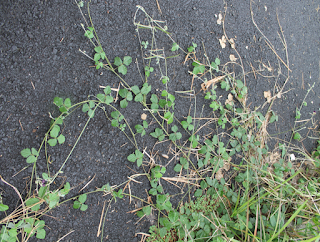Centrosema pubescens Benth.
Centrosema pubescens Flower
(Hidayat &Abdurrahman, 2017)
Centrosema pubescens Leaves
(Hidayat &Abdurrahman, 2017)
Centrosema pubescens Fruit (Legume/Pod)
(Hidayat &Abdurrahman, 2017)
Regnum :
Plantae –
Plants
Subregnum :
Tracheobionta –
Vascular plants
Divisio : Magnoliophyta –
Flowering plants
Subclassis :
Rosidae
Classis :
Magnoliopsida –
Dicotyledons
Ordo :
Fabales
Familia :
Fabaceae –
Pea family
Genus :
Centrosema (DC.) Benth. – butterfly pea
Species :
Centrosema pubescens Benth. –
flor de conchitas
Centrosema pubescens is a twining or climbing herbaceous vine with strong tendency to root at nodes of trailing stems.Annnual or perennial, with alternate leaves, and compound trifoliate with broad oval leaflets and long petioles, shortly acuminate and finely pubescent (Tropical Forages, 2017). Young leaflets and terminal portions of stolons are typically reddish. Centrosema pubescens is native to Central and South America. It is now widespread in the wet tropics from 22°S to 22°N latitude and up to an altitude of 1600 m (Teitzel et al., 1992). It grows best on humid soils. Optimal annual rainfall ranges from 1500 to 1700 mm but centro is known to tolerate 800 mm and a 3 to 4-month dry season. It withstands waterlogging and flooding and is tolerant to shade (up to 80%). Centro cannot tolerate low temperatures, grows poorly below 15°C and is severely damaged by frost (Teitzel et al., 1992).
The flowers are of papilionaceae type, purple pink to white in color, and rather large (about 3 cm wide). Stipules triangular-elongated, persistent. Inflorescence an axillary raceme with 3-5 lilac to bluish-violet flowers, each flower subtended by two striate bracteoles. Calyx campanulate, 5-teethed; standard orbicular, approx. 2 cm in diameter; wings and keel much smaller than standard, directed upwards.
The fruit is a flat linear pod and compressed with marked sides approx 13 cm long and 5-7 mm board and the tip is extended by an elongated beak. It contains 15 to 22 seeds with smooth integument, ranging from reddish-brown to black. Seeds transversely oblong to very slightly reniform , approx. 5 mm long, yellowish-greenish with dark mottles. 100-seed weight approx. 2.7 g (approx. 36,000 seeds/kg).
Centrosema pubescens sometime but not common to use as forage, and also use as ornamental or cover crop to prevent erosion and weed (Reksohadiprodjo, 1981). Like other N fixing legumes, centro is a soil improver. Its association with grass is beneficial to grass yields making N fertilizer unnecessary (Castillo et al., 2003). Centro is also used as green manure crop in rubber, coconut and oil-palm plantations (Lascano et al., 1990).
Location: Taman Bareti UPI
References
Reksohadiprodjo, Soedomo. 1981. Produksi Tanaman Hijauan Makanan Ternak Tropika. Bagian Penerbitan Fakultas Ekonomi Universitas Gajahmada Yogyakarta.
All the reference have linked to the source
Please cite this article as:
Azis, A. M. (2019). UPI Seed Plants: Centrosema pubescens Benth Online at
https://upiseedplants-one-aldi.blogspot.com/. Accessed (Date)
Please cite this article as:
Azis, A. M. (2019). UPI Seed Plants: Centrosema pubescens Benth Online at
https://upiseedplants-one-aldi.blogspot.com/. Accessed (Date)






Comments
Post a Comment